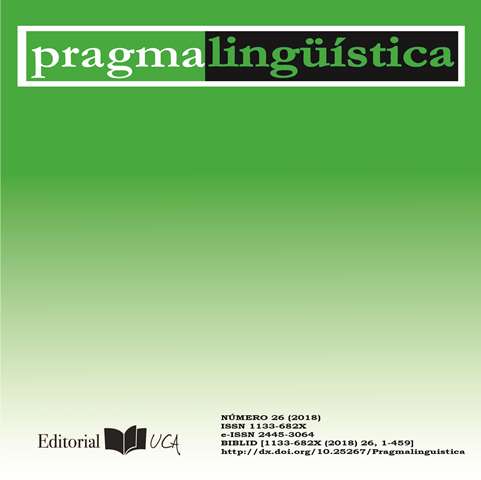La noción de significado convencional en la interfaz semántica–pragmática

DOI
https://doi.org/10.25267/Pragmalinguistica.2018.i26.04Información
Resumen
En el presente trabajo se discute la noción de “significado convencional” dentro de la interfaz semántica–pragmática. Esta noción es el punto de partida para establecer la distinción griceana entre lo dicho por el hablante y lo implicado o el contenido comunicado. En este trabajo se critica tal línea, poniendo en cuestión la utilidad de dicha noción. La discusión se divide en dos partes. La primera parte defiende que la noción de lo convencional no captura adecuadamente las propiedades de interfaz que pretenden describir y explicar quienes la adoptan. En la segunda parte se plantea que la aceptación o el rechazo con respecto a la convencionalidad como criterio de análisis del significado depende parcialmente de si podemos o no aceptar que las intuiciones sobre el contenido semántico y el enriquecimiento pragmático de las expresiones lingüísticas deben ser tenidas en cuenta en una teoría integral y adecuada del significado.Palabras clave
Descargas
Agencias de apoyo
Cómo citar
Licencia
Derechos de autor 2018 Pragmalingüística

Esta obra está bajo una licencia internacional Creative Commons Atribución-NoComercial-CompartirIgual 4.0.
Citas
ALLAN, K., & JASZCZOLT, K. M. (Eds.). (2012). The Cambridge Handbook of Pragmatics. Cambridge: Cambridge University Press.
BACH, K. (1994). Conversational impliciture. Mind and Language, 9, 124–162.
BIRNER, B. J. (2013). Introduction to Pragmatics. Oxford: Wiley-Blackwell.
BLOOMFIELD, L. (1933). Language. Londres: George Allen & Unwin.
BORG, E. (2007). Minimalism versus contextualism in semantics. En Context-sensitivity and Semantic Minimalism: New Essays on Semantics and Pragmatics (pp. 339-359). Oxford: Oxford University Press.
BÖRJESSON, K. (2014). The Semantics-Pragmatics controversy. Berlín/Boston: De Gruyter Mouton.
CARSTON, R. (2012). Metaphor and the literal/nonliteral distinction. En K. Allan & K. M. Jaszczolt (Eds.), The Cambridge Handbook of Pragmatics (pp. 469–492). Cambridge: Cambridge University Press.
CARSTON, R. (2002). Thoughts and Utterances: The Pragmatics of Explicit Communication. Oxford: Blackwell.
DEVITT, M. (2006). Intuitions in linguistics. The British Journal for the Philosophy of Science, 57, 481–513.
GONZÁLEZ VERGARA, C. (2006). La Gramática del Papel y la Referencia: una aproximación al modelo. Onomázein, 14(2), 101–140.
GRICE, H. P. (1975). Logic and conversation. En P. Cole & J. Morgan (Eds.), Syntax and Semantics, Volume 3: Speech Acts (pp. 43-58). New York: Academic Press.
HACKL, M. (2013). The syntax–semantics interface. Lingua, 130, 66–87.
HAUGH, M. (2008). Intention in pragmatics. Intercultural Pragmatics, 5(2), 99–110.
HORN, L. (2012). Implying and inferring. En K. Allan & K. M. Jaszczolt (Eds.), The Cambridge Handbook of Pragmatics (pp. 69–86). Cambridge: Cambridge University Press.
HUANG, Y. (2007). Pragmatics. New York: Oxford University Press.
JACOBSON, P. (2014). Compositional semantics: An introduction to the syntax/semantics interface. Oxford: Oxford University Press.
JASZCZOLT, K. M. (2012). Semantics/pragmatics boundary disputes. En C. Maienborn, K. von Heusinger, & P. Portner (Eds.), Semantics: An International Handbook of Natural Language Meaning (Vol. 3, pp. 2333–2360). Berlín/Boston: De Gruyter Mouton.
LEECH, G. (2014). The Pragmatics of Politeness. Nueva York: Oxford University Press.
LÓPEZ-SERENA, A. (2009). Intuition, acceptability and grammaticality: a reply to Riemer. Language Sciences, 31, 634-648.
MCNALLY, L. (2013). Semantics and Pragmatics. Wiley Interdisciplinary Reviews: Cognitive Science, 4, 285–297.
RIEMER, N. (Ed.). (2015). The Routledge Handbook of Semantics. Londres: Routledge.
RIEMER, N. (2009). Grammaticality as evidence and as prediction in a Galilean linguistics. Language Sciences, 31, 612-633.
SAUSSURE, F. DE. (1959). Curso de lingüística general. Buenos Aires: Editorial Losada.
SCHREINER, S. (2014). The syntax–semantics/pragmatics interface. En A. Carnie, Y. Sato, & D. Siddiqi (Eds.), The Routledge Handbook of Syntax (pp. 307–321). Londres: Routledge.
SPERBER, D., & WILSON, D. (2004). La Teoría de la Relevancia. Revista de Investigación Lingüística, 7, 237–286.
STOKHOF, M. (2011). Intuitions and competence in formal semantics. The Baltic International Yearbook of Cognition, Logic and Communication, 6, 1–23.
STOLTERFOHT, B., & FEATHERSTON, S. (Eds.). (2012). Empirical Approaches to Linguistic Theory. Berlín/Boston: De Gruyter Mouton.
VAN VALIN, R. (2014). Role and Reference Grammar. En A. Carnie, D. Siddiqi, & Y. Sato (Eds.), Routledge Handbook of Syntax (pp. 579–603). Londres: Routledge.
VAN VALIN, R. (2005). Exploring the syntax-semantics interface. Cambridge: Cambridge University Press.
VAN VALIN, R. (Ed.). (2008). Investigations of the Syntax–Semantics–Pragmatics Interface. Amsterdam: John Benjamins.
WILLEMS, K. (2012). Intuition, introspection and observation in linguistic inquiry. Language Sciences, 34, 665–681.






